Ijraset Journal For Research in Applied Science and Engineering Technology
- Home / Ijraset
- On This Page
- Abstract
- Introduction
- Conclusion
- References
- Copyright
IOT based Smart Parking and Traffic Management System for Modern Cities
Authors: N. Chanduja, N. Manasa, G. Anusha, Dr. Prasad Janga
DOI Link: https://doi.org/10.22214/ijraset.2024.65829
Certificate: View Certificate
Abstract
In recent times the concept of smart cities has become very popular. Thanks to the Internet of things the idea of smart city now seems to be completed. Consistent efforts are being made in the field of IoT in order to maximize the productivity and reliability of urban infrastructure. Problems such as, traffic congestion, limited car parking facilities and road safety are being addressed by IoT. In this paper, we present an IoT based cloud integrated smart parking system. The proposed Smart Parking system consists of an on-site deployment of an IoT module that is used to monitor and signalize the state of availability of each single parking space. A mobile application is also provided that allows an end user to check the availability of parking space and book a parking slot accordingly.
Introduction
I. INTRODUCTION
The concept of Internet of Things (IoT) started with things with identity communication devices. The devices could be tracked, controlled or monitored using remote computers connected through Internet. IoT extends the use of Internet providing the communication, and thus inter-network of the devices and physical objects, or ‘Things’. Internet means a vast global network of connected servers, computers, tablets and mobiles using the internationally used protocols and connecting systems. Internet enables sending, receiving, or communicating of information. Thing in English has number of uses and meanings. Dictionary meaning of ‘Thing’ is a term used to reference to a physical object, an action or idea, situation or activity, in case when we do not wish to be precise. IoT, in general consists of inter-network of the devices and physical objects, number of objects can gather the data at remote locations and communicate to units managing, acquiring, organizing and analyzing the data in the processes and services. It provides a vision where things (wearable, watch, alarm clock, home devices, surrounding objects with) become smart and behave alive through sensing, computing and communicating by embedded small devices which interact with remote objects or persons through connectivity. The scalable and robust nature of Cloud computing is allowing developers to create and host their applications on it. Cloud acts as a perfect partner for IoT as it acts as a platform where all the sensor data can be stored and accessed from remote locations. These factors gave rise to the amalgamation of both technologies thus leading to the formation of a new technology called Cloud of Things (CoT). In CoT the things (nodes) could be accessed, monitored and controlled from any remote location through the cloud. Due to high scalability in cloud any number of node could be added or Removed from the IoT system on a real time basis. In simple terms IoT can be explained in form of an equation stating: Physical Object + Controller, Sensor and Actuators + Internet = Internet of Things The idea of creating a Smart City is now becoming possible. With the emergence of the Internet of Things. One of the key issues that smart cities relate to is car parking facilities and traffic management systems. In present day cities finding an available parking spot is always difficult for drivers, and it tends to become harder with ever increasing number of private car users.
This situation can be seen as an opportunity for smart cities to undertake actions in order enhance the efficiency their parking resources thus leading to reduction in searching times, traffic congestion and road accidents. Problems pertaining to parking and traffic congestion can be solved if the drivers can be informed in advance about the availability of parking spaces at and around their intended destination. Recent advances in creating low-cost, low-power embedded systems are helping developers to build new applications for Internet of Things. Followed by the developments in sensor technology, many modern cities have opted for deploying various IoT based systems in and around the cities for the purpose of monitoring. A recent survey performed by the International Parking Institute reflects an increase in number of innovative ideas related to parking systems. At present there are certain parking systems that claim to citizens of delivering real time information about, available parking spaces. Such systems require efficient sensors to be deployed in the parking areas for monitoring the occupancy as well as quick data processing units in order to gain practical insights from data collected over various sources.
II. LITERATUREREVIEW
2015- An approach to IOT based car parking and reservation system on cloud _Vaibhav Hans, Parminder Singh Sethi, Jatin Kinra One of the challenge faced by people living in metropolitan cities of India is parking of cars at supermarkets, shops, theater, hotels, stadiums etc. This problem becomes more serious during weekends and holidays. Solutions provided in earlier work includes, image processing based automatic number plate recognition system, use of RFID tags, QR code, vehicle tracking etc. These solutions are not feasible to implement as they suffer from security as well as implementation challenges or are not cost effective. In this paper, an IoT based solution for parking of cars at supermarkets is presented using NodeMCU ESP8266. Two ultrasonic sensors are placed in each parking slot for checking the car occupancy. An android mobile app is developed which is used for the purpose of displaying available slots, dynamic fare and booking of available slot for the user selected time period. User information is collected, once a particular slot is chosen by the user. A code is generated for each booking and the same is used for validation at the entrance gate of the parking. Complete details are stored on the cloud. The prototype of the system has been developed and tested for booking slot using ESP8266 and google firebase as cloud hosting service. We found that above system is more efficient and economical for booking of parking slots at supermarkets. Automatic parking slot booking system for cars has been area of interest of many researchers. People often find difficulties in parking vehicle at public places. Many a times, it happens that, if the slot is already preoccupied, it not only wastes time, but also causes traffic jam at places like theater, play grounds, supermarkets etc. Conventional systems used in India are based on pay and park system. In this system, person has to paymoney to park his vehicle at any available slot. This system suffers from major problem of manually finding the vacant slot for parking car. In parking system with large number of parking slots, sometimes it becomes very difficult to locate the car. Human assisted parking system are available, but still it is difficult to maintain the database of parked car. Such, system also suffers from vulnerability of theft. With the ever increasing population in big cities & keeping the future demand for automatic parking of cars, Internet of Things (IoT) seems to be promising technology. IoT relies on sensors connected to IoT platforms & sending the data to cloud trough IoT Gateway. It has been said that, limitless devices can be connected through IoT. With IoT enabled technologies it is possible to acquire data, perform data analysis as well as have control of devices.
Wide range of IoT platforms are available which includes Arduino, Intel Edison, ESP, Raspberry Pi, Particle, Adafruit series etc. Many of these boards are equipped with features like, large number of I/O pins, high speed processor, inbuilt Wi-Fi module, re-configurability, operating system, portability, inbuilt memory, support to external memory & portability. This paper explains the system developed using ESP8266 which is NodeMCU. It has inbuilt Wi-Fi module and it is easy to program. Other useful features of ESP8266 include small size, low power consumption (3.3V), access point (AP) & station node, SPI, UART and I2C pins.
III. BLOCK DIAGRAM
The Block Diagram of our prototype is as shown below:
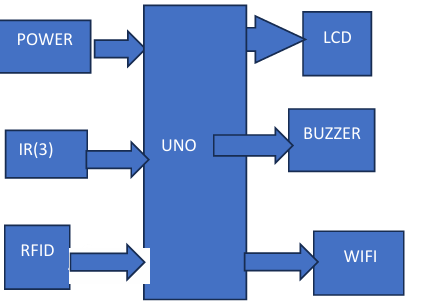
IV. COMPONENTS
A. Arduino
The Arduino board serves as the central controller for the system. IR(3) It processes data from sensors, communicates with the mobile app, and controls the watering mechanism.
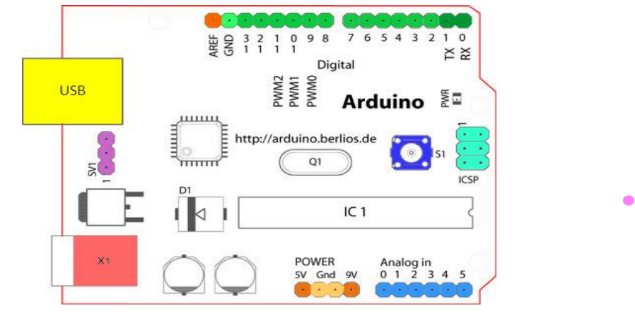
Fig: Represents Arduino layout
POWER SUPPLY: You'll need a suitable power supply to provide power to the Arduino, water pump, and other components. Ensure it can provide the necessary voltage and current.
B. ATMEGA328
ATmega328 is an 8-bit, 28-Pin AVR Microcontroller, manufactured by Microchip, follows RISC Architecture and has a flash-type program memory of 32KB. Atmega328 is the microcontroller, used in basic Arduino boards i.e Arduino UNO, Arduino Pro Mini and Arduino Nano. It hasan EEPROM memory of 1KB and its SRAM memory is 2KB.
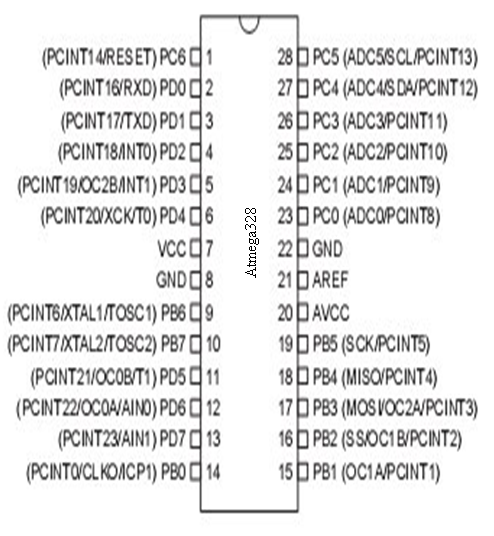
C. LCD
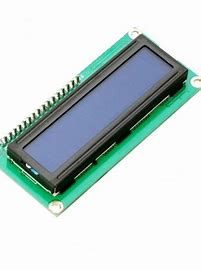
Even limited to characters based modules,there is still a wide variety of shapes and sizes available. Line lengths of 8,16,20,24,32 and 40 characters are all standard, in one, two and four line versions.
D. Buzzer

An audio signaling device like a beeper or buzzer may be electromechanical or piezoelectric or mechanical type. The main function of this is to convert the signal from audio to sound. Generally, it is powered through DC voltage and used in timers, alarm devices, printers, alarms, computers, etc. Based on the various designs, it can generate different sounds like alarm, music, bell & siren.
E. RFID
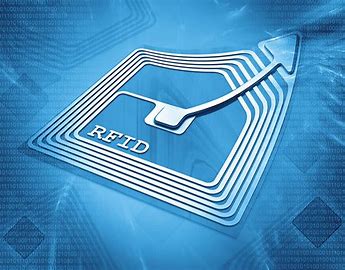
Radio-frequency identification (RFID) is a technology that uses electromagnetic fields to automatically identify and track tags attached to objects.
F. IR Sensor
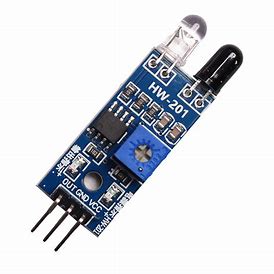
An IR sensor typically consists of an infrared emitter and a detector. The emitter sends out infrared light, which is then reflected or absorbed by objects and detected by the sensor.
G. WIFI
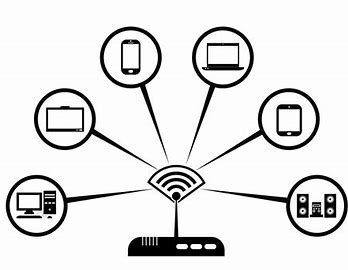
Wi-Fi (short for Wireless Fidelity) is a technology that allows electronic devices to connect to a wireless local area network (WLAN), typically using the 2.4 GHz and 5 GHz radio bands.
H. Power Supply
A regulated power supply is a device that converts unregulated AC (alternating current) into a stable DC (direct current). Here are some key points about regulated power supplies:
Components
- Transformer: Steps down the voltage from the AC mains to the required level.
- Rectifier: Converts AC to DC using diodes.
- Filter: Smooths the DC output to reduce ripple and provide a stable voltage
V. DESIGN FLOW
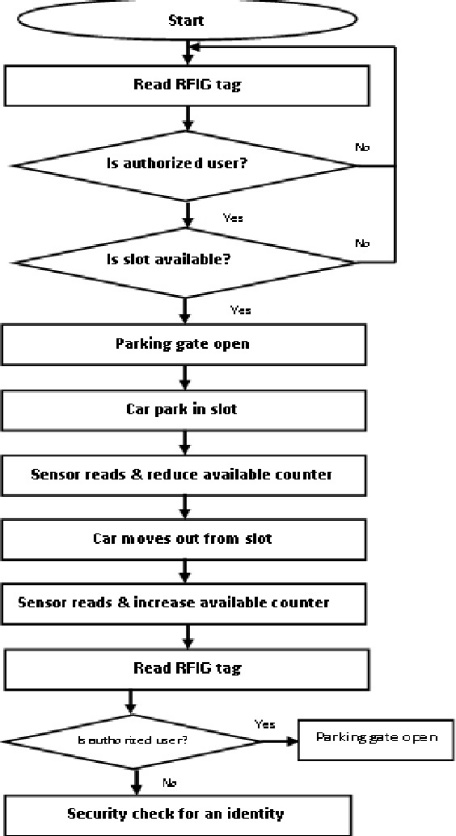
Embedded system design is a quantitative job. The pillars of the system design methodology are the separation between function and architecture, is an essential step from conception to implementation. In recent past, the search and industrial community has paid significant attention to the topic of hardware-software (HW/SW) codesign and has tackled the problem of coordinating the design of the parts to be implemented as software and the parts to be implemented as hardware avoiding the HW/SW integration problem marred the electronics system industry so long. In any large scale embedded systems design methodology, concurrency must be considered as a first class citizen at all levels of abstraction and in both hardware and software. Formal models & transformations in system design are used so that verification and synthesis can be applied to advantage in the design methodology.
VI. WORKING
An IoT-based Smart Parking and Traffic Management System for modern cities integrates various components to optimize urban mobility. The system uses RFID to identify and track vehicles as they enter or exit parking areas. RFID tags are attached to vehicles, and RFID readers placed at entry and exit points scan these tags to confirm vehicle identity and track parking duration.
IR Sensors placed in parking spaces detect whether a spot is occupied or vacant by measuring distance or reflection from the vehicle, sending real-time data to a central system. This data, combined with vehicle movement information, allows drivers to easily find available parking spots.The Arduino acts as the central controller, processing data from the RFID readers, IR sensors, and user inputs. It also communicates with the cloud or local server to manage parking information. LCD screens are used to display real-time parking availability at various locations or guide drivers to open spaces.The Power Supply ensures that all components, including the sensors and Arduino, receive the necessary energy to operate. Wi-Fi connectivity enables seamless communication between the parking system, cloud-based servers, and mobile apps, providing real-time updates to users.
VII. RESULT
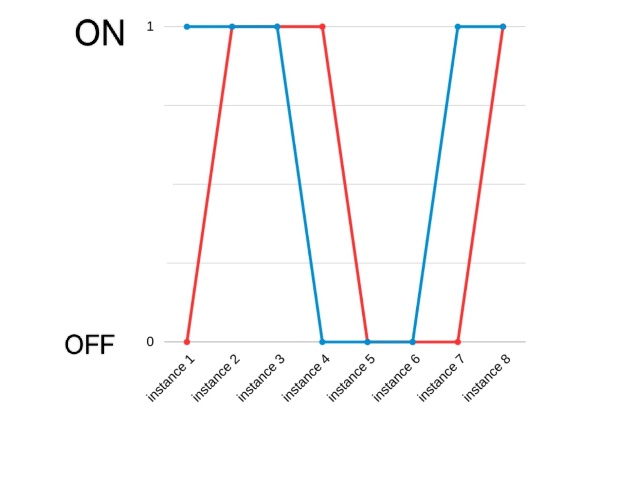
Fig: Represents the results of relay ON in different instances in two days.
Where,
Red color represents Day-1
Blue color represents Day-2
The line chart presented here offers an insightful view of the relay module's operation over the course of two days within the context of a smart gardening system. It provides a visual representation of when the relay module, responsible for controlling the water pump, is in the "On" state, indicating the active state of the water pump, and when it transitions to the "Off" state, denoting the water pump's inactivity. Understanding the relationship between the relay module's status and specific conditions, such as soil moisture and temperature, is pivotal for effective plant care and irrigation management in the realm of smart gardening. The line chart is divided into two distinct days, marked in different colors, and further segmented into morning and evening periods, shedding light on the module's dynamic response to changing environmental factors. Let's delve into the detailed interpretation of the line chart to gain a comprehensive understanding of the relay module's behavior and its relevance to the smart gardening system.
Day 1 (Red Line)
- Initially "Off" in the morning, indicating water pump inactivity due to favorable conditions.
- Shifts to "On" from instances 2 to 4, activating the pump.
- Returns to "Off" as morning conditions favor inactivity.
- Stays "Off" in the evening (instances 5-7) due to suitable conditions.
- Switches back to "On" at the eighth instance, signaling a change in evening conditions.
Day 2 (Blue Line)
- Begins "On," signifying pump activity in the morning under favorable conditions.
- Shifts to "Off" at the fourth instance due to changing morning conditions.
- Remains "Off" during the evening (instances 5-7) as conditions favor inactivity.
- Turns "On" at the eighth instance, indicating a shift in evening conditions.
This concise interpretation highlights the relay module's role in responding to environmental conditions for effective automated plant irrigation in smart gardening. Understanding these patterns is essential for efficient watering.
Conclusion
The concept of Smart Cities have always been a dream for humanitySince the past couple of years advancements have been made in making smart cities a reality. The growth of Internet of Things and Cloud technologies have given rise to new possibilities in terms of smart cities. Smart parking facilities and traffic management systems have always been at the core of constructing smart cities. In this paper, we address the issue of parking and present an IoT based Cloud integrated smart parking system. The system that we propose provides real time information regarding availability of parking slots in a parking area. Users from remote locations could book a parking slot for them by the use of our mobile application. The efforts made in this paper are indented to improve the parking facilities of a city and thereby aiming to enhance the quality of life of its people.
References
[1] 2015- An approach to IOT based car parking and reservation system on cloud _Vaibhav Hans, Parminder Singh Sethi, Jatin Kinra. [2] 2016- Novel vehicle booking system using IOT_S. Vidhya Sagar; B. Balakiruthiga; A. Sivanesh Kumar [3] Marking, N.V.W., 2014. Multi-Wavelet Based On Non-Visible Water Marking. [4] 2016- Performance notification in a reservation-basedparkingsystem _PujiantoYugopuspito; Ryant A. Herwansyah; Dion Krisnadi; Sutrisno Cahya; Frans Panduwinata [5] 2016- Toward service oriented design for reservation-based parking _PujiantoYugopuspito; Frans Panduwinata; Sutrisno; Julinda Pangaribuan [6] Venkatapathi, Pallam, Kondu Vinay, Kummathi Harshavardhan Reddy, Mulli Karthik, and Sudhakar Alluri. \"Real Time Driver Gaze Tracking and Eyes off the Road Detection System.\" [7] 2017- A navigation and reservation based smart parking platform using genetic optimization for smart cities-lhan Aydin; Mehmet Karakose; Ebru Karakose. [8] Zheng, Y., Rajasegarar, S., & Leckie, C. (2015, April). Parking availability prediction for sensor-enabled car parks in smart cities.In Intelligent Sensors, Sensor Networks and Information Processing (ISSNIP), 2015 IEEE Tenth International Conference on (pp. 1-6). [9] Venkatapathi, Pallam, Kondu Vinay, Kummathi Harshavardhan Reddy, Mulli Karthik, and Sudhakar Alluri. \"Traffic Signal Controller System and Vehicle Count-Based Road Congestion Detection.\" [10] Han, D. M., & Lim, J. H. (2010). Smart home energy management system using IEEE 802.15. 4 and zigbee. Consumer Electronics, IEEE Transactions on, 56(3), 1403-1410. [11] Pallam, Venkatapathi, and PBheerendra KUMAR. \"Computer Controlled Intrusion-Detector and Automatic Firing-Unit for Border Security.\" International Journal Of Advanced Technology And Innovative Research, ISSN (2014): 955-960. [12] Parwekar, P. (2011, September). From Internet of Things towards cloud of things. In Computer and Communication Technology (ICCCT), 2011 2nd International Conference on (pp. 329-333). IEEE. [13] Santosh, M., and Venkatapathi Pallam. \"Vehicle Position of Self-Recognition using Ultra High Frequency Passive RFID Tags.\" International Journal of Scientific Engineering and Technology Research 3, no. 32 (2014): 6294-6300. [14] Tejaswi, P., and P. Venkatapathi. \"IOT based smart home with load control.\" International Journal for Research in Applied Science & Engineering Technology 8 (2020): 876-881. [15] Pallam Venkatapathi Haripal Reddy Kota, Barre Nikhitha, Karedla Akshitha, Pudota Praveen Naidu\" IOT E-Circular Notification for Students Using a WIFI-Based LED Advertising Board.\" International Journal for Research in Applied Science & Engineering Technology, ISSN: 2321-9653, Volume 11 Issue XI Nov 2023: 1080-1084
Copyright
Copyright © 2024 N. Chanduja, N. Manasa, G. Anusha, Dr. Prasad Janga. This is an open access article distributed under the Creative Commons Attribution License, which permits unrestricted use, distribution, and reproduction in any medium, provided the original work is properly cited.

Download Paper
Paper Id : IJRASET65829
Publish Date : 2024-12-09
ISSN : 2321-9653
Publisher Name : IJRASET
DOI Link : Click Here
 Submit Paper Online
Submit Paper Online

